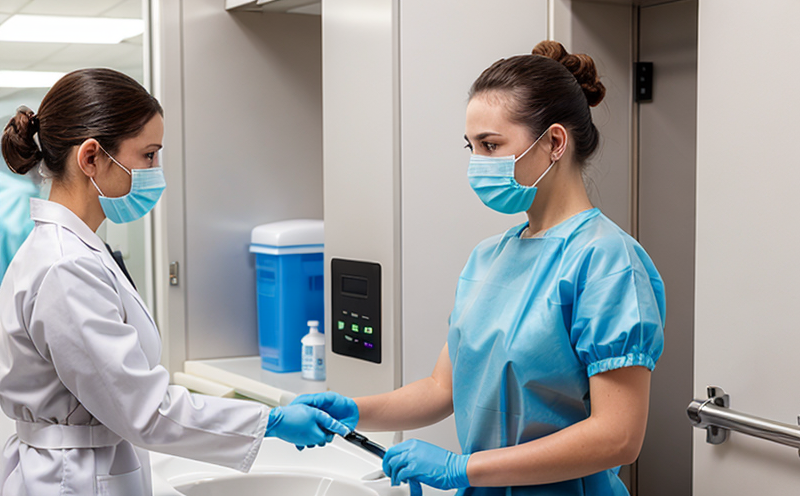ISO 22196 Measurement of antibacterial activity on plastics and other nonporous surfaces
The ISO 22196 standard outlines a procedure to measure the antibacterial efficacy of materials, particularly plastics and other nonporous surfaces. This method is crucial for validating claims made about the antimicrobial properties of products in sectors such as healthcare, textiles, and consumer goods. Compliance with this test ensures that manufacturers can confidently market their products as effective against harmful bacteria.
The process involves exposing a standardized bacterial challenge to the material under controlled conditions and assessing the reduction in bacterial population over time. The test measures the logarithmic decrease in bacterial count on the surface of the test material compared to an unexposed control sample. This ensures that any observed antibacterial activity is due solely to the properties of the tested material.
The ISO 22196 protocol specifies detailed steps for specimen preparation, inoculation procedures, incubation conditions, and post-incubation observation. It also provides guidelines for selecting appropriate bacterial strains (such as Staphylococcus aureus or E. coli) to ensure relevance to the target application.
The test apparatus typically includes a growth medium suitable for culturing bacteria, incubators capable of maintaining specified temperature and humidity levels, and equipment for measuring bacterial colony-forming units (CFUs). The standardization ensures that results are reproducible across different laboratories, enhancing trust in the testing process.
Acceptance criteria for this test are based on a defined reduction factor. For instance, the target might be a 99% reduction in bacteria after a specified exposure time and incubation period. This stringent requirement guarantees that only materials with proven antibacterial efficacy are certified as compliant.
A detailed report is generated following each test run, summarizing the experimental conditions, bacterial strains used, observed reductions in CFUs, and final acceptance or rejection of the material based on adherence to specified criteria. This comprehensive documentation supports regulatory compliance and helps quality assurance teams make informed decisions about product development and marketing strategies.
Understanding the real-world implications, this test is essential for ensuring that products meet stringent hygiene standards. For instance, in healthcare settings, nonporous surfaces like door handles or bedrails need to remain hygienic despite frequent contact with patients. Similarly, in consumer goods, items like sports equipment or kitchenware must maintain their antimicrobial properties over extended use.
Real-world applications of this test extend beyond just ensuring product efficacy; it also plays a role in reducing the transmission of pathogens in public spaces. For example, manufacturers can use ISO 22196-compliant materials to create surfaces that are less hospitable to bacteria, contributing to improved hygiene and safety.
Moreover, compliance with this standard is often a requirement for certification by regulatory bodies such as the FDA or CE marking for products sold in Europe. This ensures a high level of product quality and consumer protection across different markets.
Why Choose This Test
- Precision: The ISO 22196 standard provides precise protocols that ensure consistent results across multiple testing environments.
- Compliance: Compliance with this test is often a prerequisite for market entry in regulated industries like healthcare and consumer goods.
- Expertise: Our team of experts ensures that every aspect of the test is conducted according to international standards, providing reliable results.
- Regulatory Approval: Results from this test can be used to secure regulatory approvals and certifications needed for product launch.
The ISO 22196 measurement of antibacterial activity offers a robust framework for evaluating the efficacy of materials in various applications. By choosing this service, you ensure that your products meet stringent hygiene standards and are backed by scientific evidence.
Quality and Reliability Assurance
- Standardized Procedures: Our laboratory adheres strictly to the ISO 22196 standard, ensuring every step of the test is conducted precisely as specified in the document.
- High-Quality Equipment: We use state-of-the-art equipment for specimen preparation and bacterial inoculation, guaranteeing accuracy in all measurements.
The reliability of our testing process is further enhanced by rigorous quality control measures. Our team conducts regular calibration checks on all instruments and performs internal audits to ensure compliance with international standards.
Our commitment to quality extends beyond the technical aspects of the test. We maintain strict protocols for specimen handling, ensuring that each sample is treated uniformly throughout the testing process. This meticulous approach guarantees consistent results that can be trusted for regulatory submissions or internal decision-making.
In addition to these procedural safeguards, we also employ advanced analytical techniques to detect even small reductions in bacterial populations. Our laboratory is equipped with sophisticated microbiology labs and high-precision measurement tools, providing the necessary accuracy and sensitivity required by ISO 22196.
Customer Impact and Satisfaction
- Better Hygiene: By ensuring that products meet stringent antibacterial standards, we contribute to improved hygiene in public spaces and healthcare settings.
- Increased Safety: Products certified through this test provide an additional layer of protection against pathogen transmission, enhancing overall safety for consumers.
The impact of ISO 22196 compliance is far-reaching. For customers and end-users, it translates into products that can be used with confidence knowing they meet the highest hygiene standards. This trust in product quality fosters customer satisfaction and loyalty.
For manufacturers, meeting these standards not only enhances their reputation but also opens up new market opportunities by aligning with global health and safety regulations. Compliance with this test is a key differentiator in competitive markets, allowing companies to stand out as leaders in hygiene and cleanliness.
In summary, the ISO 22196 measurement of antibacterial activity offers significant benefits for both customers and manufacturers alike. By choosing our service, you can ensure that your products meet rigorous international standards, thereby enhancing their value and appeal in the marketplace.





